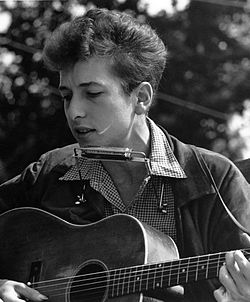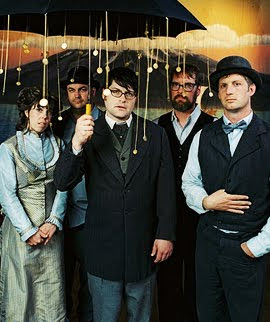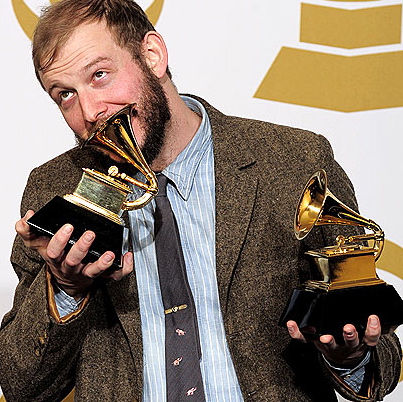Folk The Revival: Traditions Taking Over
posted in: Features
 Sitting around a fire after a long day of travelling, roasting the rewards of the hunt over an open flame, singing songs of home, of protest, of past adventures; this is the heart and soul of folk music, which has been shared by people all over the world for centuries. Folk music is the original ethos that embodies all attributes of culture, so it’s no wonder that the genre has stuck around for so long. However, in the last eighty years or so, folk music has taken a back seat to other popular genres. There was, of course, the revolutionary folk revival of the ’50s and ’60s that left us with the soothing poetics of Bob Dylan, The Byrds, and Simon & Garfunkel, but this movement ultimately sank back to the shadows as the 70’s brought on new musical trends. What most people don’t know, however, is that folk music has been silently plotting another massive revival.
Sitting around a fire after a long day of travelling, roasting the rewards of the hunt over an open flame, singing songs of home, of protest, of past adventures; this is the heart and soul of folk music, which has been shared by people all over the world for centuries. Folk music is the original ethos that embodies all attributes of culture, so it’s no wonder that the genre has stuck around for so long. However, in the last eighty years or so, folk music has taken a back seat to other popular genres. There was, of course, the revolutionary folk revival of the ’50s and ’60s that left us with the soothing poetics of Bob Dylan, The Byrds, and Simon & Garfunkel, but this movement ultimately sank back to the shadows as the 70’s brought on new musical trends. What most people don’t know, however, is that folk music has been silently plotting another massive revival.
That’s right, everyone, folk is back. That’s not to say it was necessarily gone, but it’s on its way to regaining overall respect on popular music charts once again. Of course, folk has always had its own niche in the industry, but it has rarely stepped very far from this realm in recent years. The popular music scene is generally overrun with modern rock, R&B, and pop, but there is strong evidence that folk is creeping its way back into the spotlight. In fact, the song currently sitting at the top of Billboard’s Hot 100 chart is Carly Rae Jepsen‘s ˜Call Me Maybe’, which, to the surprise of many, was actually written as a folk song. This chart has also featured artists like Mumford & Sons, Fleet Foxes, and Of Monsters And Men who all have strong folk rock influences in their music. The appearances of groups like these on popular charts has since introduced a new generation of fans to the rich heritage of folk music styles that originated hundreds of years ago, thus propelling the cause to return folk to its original status in the industry.
 The development of this growing resurgence can also be largely attributed to the popularity of the indie movement. Independent music is generally described as having independence from major commercial record labels, but has since developed into its own genre. Indie rock is a sub genre under alternative rock, and includes several of its own sub genres such as indie pop, grunge, jangle pop, and low-fi. Indie rock songs often include jangly guitar, unusual vocals, and exploration of instrumentation and arrangement, also common among indie folk songs, a term developed in the 1990s from singer-songwriters taking influences from both indie rock and folk artists. This synthesis of genres brought a new sound to the industry that hadn’t been explored much since the original folk revival. As it developed further, indie folk was the perfect bridge that introduced fans of popular alternative rock to bands like The Decemberists, Fleet Foxes, and Bon Iver. Then, as indie folk grew, traditional folk began to benefit by association.
The development of this growing resurgence can also be largely attributed to the popularity of the indie movement. Independent music is generally described as having independence from major commercial record labels, but has since developed into its own genre. Indie rock is a sub genre under alternative rock, and includes several of its own sub genres such as indie pop, grunge, jangle pop, and low-fi. Indie rock songs often include jangly guitar, unusual vocals, and exploration of instrumentation and arrangement, also common among indie folk songs, a term developed in the 1990s from singer-songwriters taking influences from both indie rock and folk artists. This synthesis of genres brought a new sound to the industry that hadn’t been explored much since the original folk revival. As it developed further, indie folk was the perfect bridge that introduced fans of popular alternative rock to bands like The Decemberists, Fleet Foxes, and Bon Iver. Then, as indie folk grew, traditional folk began to benefit by association.
Another major factor that is contributing to this increase of tradition and culture is the interest in rekindling the demand of forgotten trends. Much like the influence of ’80s electro-pop surging through the aughts, once a fad is burnt out and left alone for a while, people tend to crave it again like a long discarded toy that is suddenly rediscovered, arousing a sense of nostalgic sentiment. Past enthusiasts are revisiting folk music and presenting it to a new generation of younger listeners that are discovering it for the first time. Now the classic genre is colliding with modern twists and inflating like a fresh, new trend once again, and it’s quickly beginning to take over the twenty-tens.
 This brings us to where we are today. Indie folk has been widely accepted as an established genre, and these artists are making big names for themselves. Bon Iver, for example, walked away from the 2012 GRAMMY Awards with a pair of golden gramophones for Best Alternative Album and Best New Artist. Increasingly more folk artists are surfacing every day and are designing the new forms of a close-to-the-heart tradition. It’s good to see that we haven’t forgotten where we came from, and with folk leading the way, we’re blazing the musical trails for the future.
This brings us to where we are today. Indie folk has been widely accepted as an established genre, and these artists are making big names for themselves. Bon Iver, for example, walked away from the 2012 GRAMMY Awards with a pair of golden gramophones for Best Alternative Album and Best New Artist. Increasingly more folk artists are surfacing every day and are designing the new forms of a close-to-the-heart tradition. It’s good to see that we haven’t forgotten where we came from, and with folk leading the way, we’re blazing the musical trails for the future.
Here are 20 tracks from some popular folk/indie folk bands along with some of OurStage’s own folk artists that are bringing back the folk sound and all its heritage. Relax with these revolutionary songs of love, home, and adventure.
